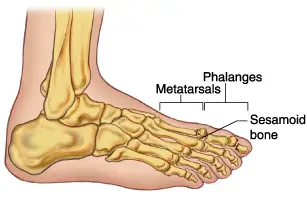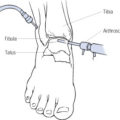*This page may contain affiliate links. When you buy through these links, we may earn a small commission at no extra cost to you.
People often witness pain under their big toe’s joint – it can be due to a medical condition called Sesamoiditis.
A sesamoid is the 2 small oval seed-shaped bones present in the foot, and its purpose is to absorb the excess weight to protect the tendon that runs on the underside of the toe.
These Sesamoid foot bones elevate the toe, which is also known as the hallux.
This assists in increasing the mechanical advantage of the tendon bend that hallux towards walking on the surface.
The Anatomy

The two Sesamoid bone feet are found under the big toe of the foot.
The Sesamoid closer to the little toe side of the foot is known as “Fibular Sesamoid,” and the Sesamoid bone that is found under the big toe is known as “Tibial Sesamoid.”
As said earlier, the purpose of the Sesamoid bone is to protect the tendon of the flexor halluces longus muscle.
This is the bone that increases the strength of the muscle by providing it good support underneath, bearing the majority of the body weight on the inside of the foot.
What Is Sesamoiditis?
When the individual develops pain underneath the foot, it is usually due to Sesamoiditis.
Sesamoiditis is an inflammation of the Sesamoid bones in the forefoot.
It has been discovered that Seasomoid bones are not connected to any other joints and bones of the body; instead, they are connected with the embedded muscles or tendons of the human body.
There is no definite reason to develop Sesamoiditis. This is an inflammation and is usually caused due to repetitive trauma.
There are redness and swelling seen under the big toe during this condition.
These Sesamoiditis symptoms are commonly witnessed in athletics, young adults, dancers as well as women who wear high heel shoes.
The symptoms of Sesamoiditis are mostly seen in the tendons, bones, and the surrounding tissues in the joint.
With the increased activity, it can lead to severe pain and hampering of foot movement.
Diagnosing Sesamoid
A foot specialist usually diagnoses the medical condition with a simple physical exam. The X-rays are recommended to confirm whether it is a sesamoid fracture or not.
Your health practitioner may need to gather your entire medical history that may follow a foot examination.
During the physical exam, the doctor may ask you a few questions regarding the pain in the foot and about what is kind of activities after doing which you experience acute pain.
If your Sesamoid bone fracture is not detected in the X-ray, your doctor is most likely to prescribe you an MRI or bone scan to confirm the same.
Causes of Sesamoiditis Pain
Unlike other foot problems, the reason for developing Sesamoiditis varies.
The most common reasons for developing Sesamoiditis pain include:
Increased Activity:
It is perhaps the major cause of developing Sesamoiditis.
It happens suddenly when you are exercising or running or getting sports training which aggravates the toe joint greatly.
Activities that cause a repetitive impact underneath your feet can also be the reason for getting this problem.
This medical problem is very commonly found in ballet dancers, baseball players, athletics, and soccer players.
Bony Feet:
The bony feet are those who don’t have enough fat in their foot to protect the Seasomoid bones from any vigorous impact.
Individuals with high arches in their feet tend to put the majority of the pressure on the balls of their feet and are prone to getting this problem easily.
How To Treat Sesamoiditis At Home?
The pain in the Sesamoid bones is due to the presence of callused skin; the doctor may remove the callus with the help of a scalpel.
The first line of treatment is to get the pressure on the bone immediately.
Apart from this, the other non-surgical treatment includes taking rest and applying cold therapy to ease inflammation and pain.
Sometimes electrotherapy treatment is also applied to reduce the pain caused due to Sesamoiditis.
Severe problems may not get treated as such and may require surgery. The most common surgical procedure for Sesamoiditis is “Sesamoidectomy.”
After the surgery, the individual is recommended to walk with crutches for 4 to 6 weeks.
The doctor may prescribe some joint exercise and a PediFix sesamoid relief sleeve to avoid the stiffness in the bones.
Your doctor may also advise using specially designed shoes for sesamoiditis to get relief.
Incoming search terms:- tibial/fibular sesamoids
- magnet therapy and sesamoiditis
- seasmoiditis and ankle pin






